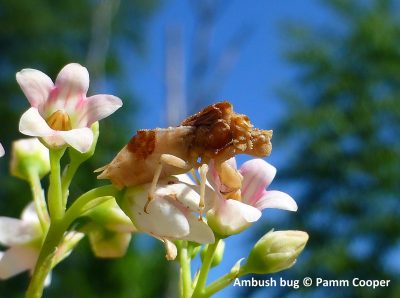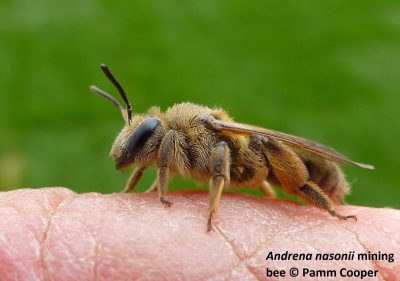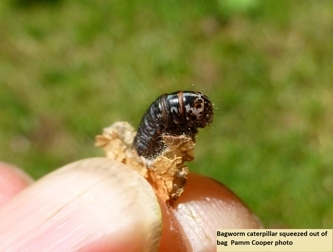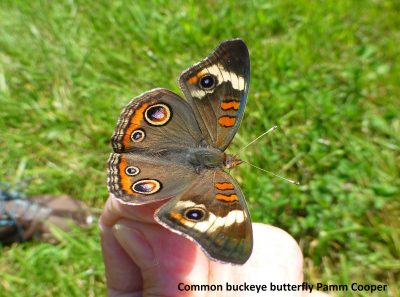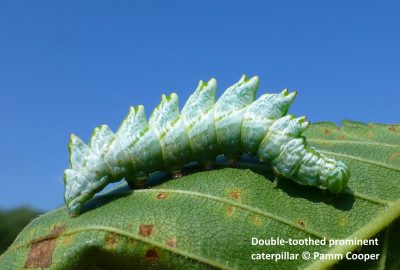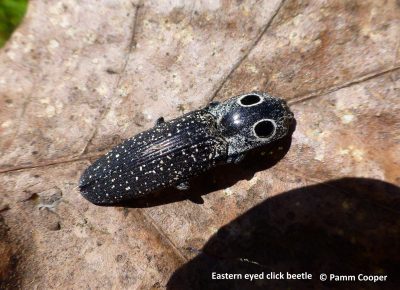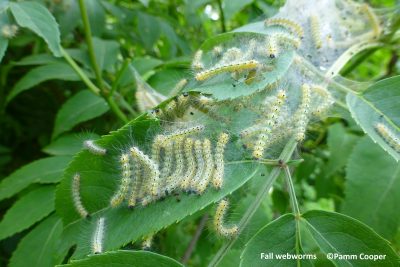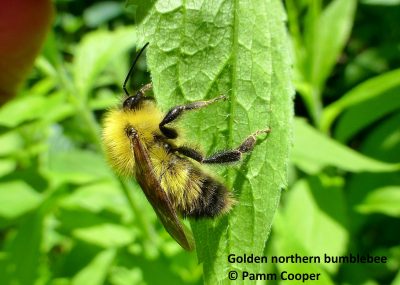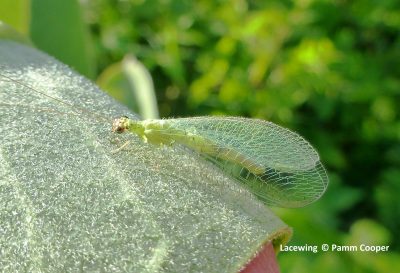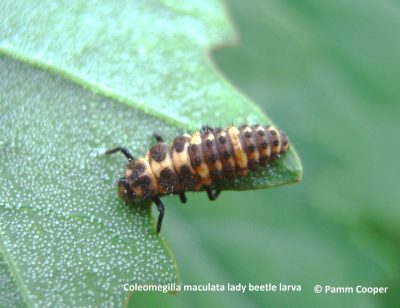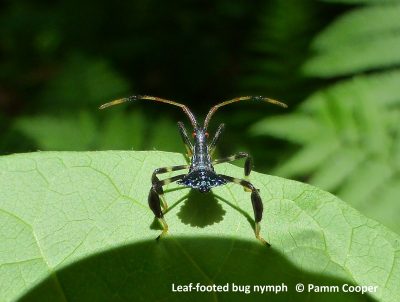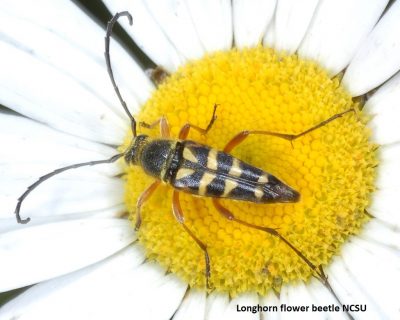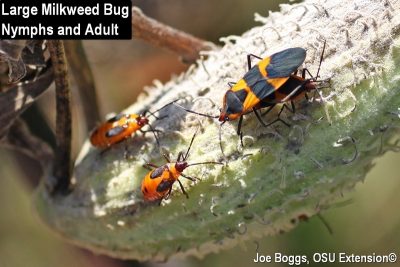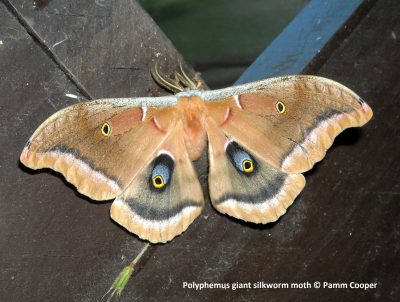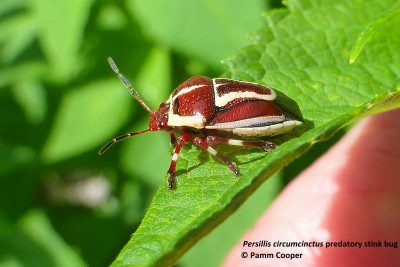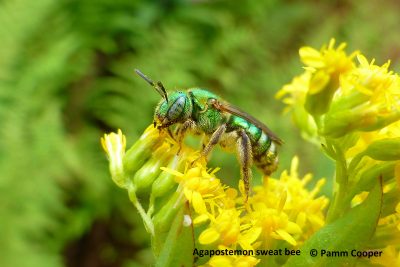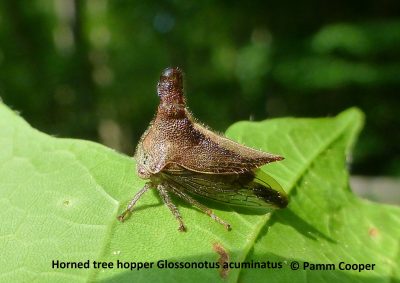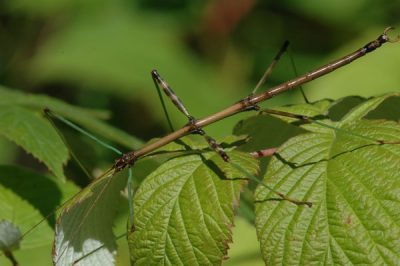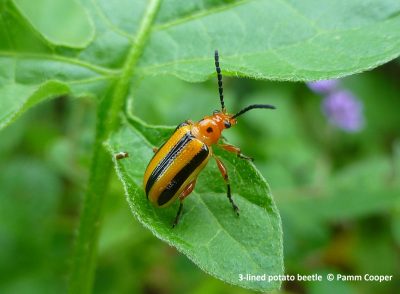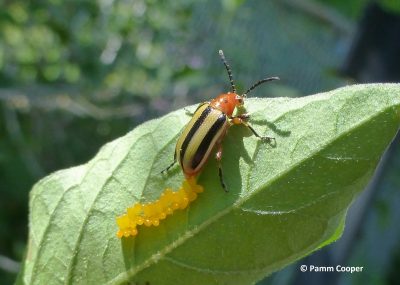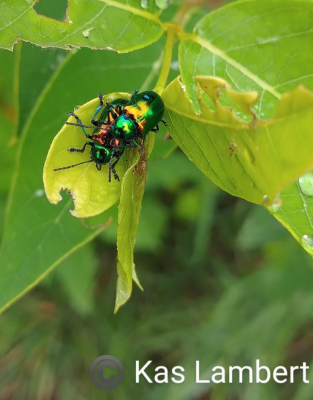Click on the bug name to learn more.
Acorn Weevil
Conotrachelus posticatus
- It is a 4-10mm long brown and black beetle
- It has a long snout which makes it easy to identify
- The female lays eggs in green acorns, the larvae develop in the acorn and eat the interior. In the fall, the acorns drop to the ground, the larvae chew holes in their respective acorns, leave the acorns and burrow into the soil. They overwinter in the soil as pupae
- Large numbers of these beetles can decrease the number of available acorns for developing into new trees
- Weevil wasps are natural predators of acorn weevils
Ambush Bug
Phymata spp.
- This is a true bug (Hemiptera) and is a subfamily of assassin bugs
- It has hooked forelegs with a wide femur section
- It has clubbed antennae and a wide back portion of the abdomen
- They are seen in open, sunny areas and almost always on flowers in the sunflower/daisy family
- They wait patiently on the flower heads to “ambush” their insect prey
- Their colors, patterns and shapes serve as good camouflage as they wait for their prey
American Carrion Beetle
Necrophila Americana
- Adults are 0.5 to 0.75” long
- They have a yellow pronotum with a large black spot in the middle
- Adults live primarily in moist areas and lay eggs on dead animals
- The larvae eat the corpse and help return nutrients from dead animals into the ecosystem
- Adults eat fly maggots and some carrion (dead animals)
Andrena Mining Bee
Andrena spp.
- Are over 1300 species of these bees worldwide
- Are small to medium size (0.3 - 0.7” long)
- These black, dull metallic blue or green hairy bees are usually seen in the spring
- Females have facial foveae (hairy grooves on their faces) and large brushes of hair on the upper portions of their legs to hold pollen
- They are solitary and nest in the ground, often close to their neighbors’ nests
- They get their name from their method of nesting (can dig tunnels 12 to 15 body lengths deep)
Aphids
- Soft-bodied insects that use piercing-sucking mouthparts to feed on plant sap
- Infestations result from small numbers of winged aphids flying to the plant and depositing several wingless young on it
- The wingless young mature in 7-10 days and produce live young
- Less than a dozen aphid “colonizers” can produce hundreds to thousands of aphids in a few weeks
- They produce large quantities of a sugary liquid waste called honeydew
- Their feeding on flower buds and fruit can cause malformed flowers and fruit
- They can transmit plant viruses
Bagworm Caterpillar
Thyridopteryx ephemeraeformis
- Distributed widely in North, South and Central America
- Can feed on over 50 families of deciduous and evergreen trees
- Juniper, arborvitae, live oak, Southern red cedar and willow are some of the more common host plants
- Females remain in a caterpillar-like state and stay enclosed in their bags throughout their lives
- As the female grows, the size of the bag grows
- Females live a few weeks
Brown Marmorated Stink Bug
Halyomorpha halys
- Adults are 0.66” long and have shades of brown on both the upper and lower portions of their bodies
- They are shield shaped with a thin proboscis
- They have light bands on their antennae which helps to distinguish them from other stink bugs
- There are patches of coppery or bluish metallic colored round depressions on their head and pronotum
- Scent glands on the top of their abdomen and underside of their thorax result in the characteristic odor
Common Buckeye Butterfly
Junonia coenia
- Medium sized butterfly with several large conspicuous eye spots on the wings
- They are brown with orange, yellow and purple spots
- They have a wingspan of 1.75” to 2.75”
- Females are larger than males
- They live in open, sunny landscapes
Double-Toothed Prominent Caterpillar
Nerice bidentata
- The backs of the double toothed prominent caterpillars imitate the double toothed elm leaves which they like to eat
- The profile of the caterpillar is similar to the leaf edges of its preferred food plant which provides good camouflage
- They are chalky green
- They become a two-toned moth – part dark brown and part tan
- The moth’s colors run vertically with dark brown on the outer wings and tan in the middle
Dragonfly
Anisoptera spp.
- Has a long, slender body and membranous wings
- Has a large head with compound eyes
- Rests with wings held horizontally
- Prefers an aquatic environment
- Eats gnats, mayflies, mosquitoes, and caddisflies
- Nymph is called a naiad
Eyed Click Beetle
Alaus oculatus
- Spends most of its life (2-5 years) as a larval “wireworm”
- As the larva, it eats many undesirable insect larvae including wood boring beetles and flies
- Larvae, which are stocky, yellow-brown segmented worms up to 2” long, can be found under logs and in dark, damp places
- Adult is black with two large false eyes on its pronotum and is approximately 1” long
- Has a hinged joint between the head and thorax which allows it to arch its back, snap the hinge and flip over
- This action creates a clicking noise and frightens predators
Fall Webworm
Hyphantria cunea
- Fall webworms develop into adult moths which are bright white with some orange markings on their bodies and legs and a wingspan of 1.25”
- Adults lay eggs in late June and early July
- Larvae are hairy and have lime green bodies with black spots
- Larvae in the north have black heads
- Initially the larvae feed on the leaf epidermis causing skeletonization
- As the larvae grow, they feed on the entire leaf and spin silk which eventually covers the leaves and then entire branches
- They cause minor defoliation in most areas and are the most common tent-making defoliator in North America
- Fall webworms serve as food for many natural enemy species who can reduce their population and environmental impact
Golden Northern Bumblebee
Bombus fervidus
- Found throughout northern US and into portions of Arkansas, Alabama, Georgia and North Carolina. Mostly concentrated in Northeast US.
- Lives and nests in grassy, open areas including forest clearings and along roadsides.
- Nests can be both above and below ground, but usually above, and constructed of grass.
- An important pollinator of many plants. Pollen is used to make honey, which feeds the queen and brood.
- Face and head are mostly black with a black stripe on abdomen between the wings. The rest of the body is yellow and covered with thick hair.
- Communicates mainly by performing special dances, which may include messages about the location of food or warning that danger is near.
- All but the queen die in the fall. The queen burrows underground for the winter and reemerges in the spring to start a new colony.
- Males are reserved for mating.
Lacewing
Chrysoperla rufilabris
- Beneficial insects that love to eat aphids, thrips, beetles, small caterpillars, and soft scales
- Adults are 0.5 to 1 inch long, have delicate clear wings with many veins, and hold their wings over their bodies when at rest
- Most lacewing adults feed only on pollen, nectar, and honeydew
- Females lay their eggs on 1⁄2-inch stalks, either individually or in groups. The stalks may help protect newly-hatched larvae from being eaten by others and reduce the risk that the eggs or developing larvae may be parasitized
Leaf-Footed Bug
Leptoglossus zonatus, L. clypealis, and L. occidentalis
- Majority of species are found in the southern United States, but they range across the entire North American continent.
- Get their name from the small leaf-like enlargements on the hind legs
- Relatively large bugs, up to one inch in length, are usually brown with a white band on their folded wings but can also be grayish or black.
- Nymphs feed on ash trees and other plants.
- Adults feed on plant juices and can be found on a wide variety of vegetation
- They have a long sucking mouthpart that pierces the flowers or fruit, causing considerable damage.
- Adults emerge in spring and feed on flowers and newly forming seeds.
- There are five nymph stages, called instars, that produce most of the damage
- If held too long or crushed, they emit a foul odor.
Longhorn Flower Beetle
Strangalia famelica
- Found on flowers, especially umbel-shaped flowers of the carrot/parsley/celery family, where they feed on pollen and nectar
- Considered plant pollinators
- Most species have narrow bodies and very long legs and antennae
- Not to be confused with the Asian Longhorn Beetle, which is invasive.
- Spend their larval days as borers which select trees that are stressed, dying, or dead.
- They are not considered pests
Milkweed Bug
Oncopeltus fasciatus
- Reddish orange insects with a conspicuous black band across the middle and two large diamond-shaped black patches fore and aft. They are 0.5 to 0.75 inches long.
- Piercing/sucking insects that pierce the walls of seed pods to feed on the seed and then eat the green tissue of plants
- Once milkweeds develop seed pods, milkweed bugs emerge from their sheltered spots to feed and reproduce.
- Nymphs emerge as tiny, elongate, red insects and develop and grow through five molts. Adult bugs emerge from the fifth molt.
- They feed on sap from the seed pods without disturbing monarch butterfly caterpillars and other insects that may be on other parts of the plant.
- They store toxins they consume when feeding on the milkweed plants and use them for self-defense.
- Some populations migrate south in the fall to spend the winter and move back north in spring, following developing milkweed.
Polyphemus Moth
Antheraea polyphemus
- Found from southern Canada into Mexico and in all of the lower 48 states except for Arizona and Nevada
- Inhabits deciduous hardwood forests, urban areas, orchards, and wetlands.
- Adult wingspan is approximately 4 to 6 inches. The upper surface of the wings is various shades of reddish brown, gray, light brown or yellow-brown with transparent eyespots
- Antennae are comb-like on four sides with those of males being larger than those of females.
- Eggs are slightly oval, flattened, white with two broad brown rings and are cemented to the substrate with a dark brown adhesive.
- Has five larval instars
- The single-layered cocoon is thicker and more elliptical than the cocoon of the Luna moth
- Adults are nocturnal and strongly attracted to light - particularly UV wavelengths. Light pollution from man-made sources (particularly mercury vapor street lights) may deter mating and have a negative impact on their populations in urban areas
- Caterpillars greatly resemble caterpillars of Luna moths
- Caterpillars feed on leaves of broad-leaved trees and shrubs such as sweetgum (Liquidambar), birch (Betula), grape (Vitis), hickory (Carya), maple (Acer), oak (Quercus), willow (Salix), and members of the rose family (Rosaceae).
Predatory Stink Bug
Euthyrhynchus floridanus
- Named because of their ability to release droplets of aromatic compounds that smell and taste bad to predators.
- Found in all parts of the US
- Distinguished by their shield shaped bodies and their long straw-like mouthparts which they keep tucked under their bodies when not in use
- Beneficial because they prey on other insects. Are generally not picky but some prefer a specific insect.
- Not all stink bugs are predatory. Some are pests, like the brown marmorated stink bug.
- Females lay their barrel-shaped eggs on leaves.
- The nymphs go through different stages of molting before achieving their mature adult form.
- As nymphs molt, colors change and the oval shape of the nymph evolves into the mature shield shape where wings are developed into their functional form.
Sweat Bee
Family = Halictidae
- More than 500 species in North America north of Mexico
- Most members of this family are black or brown, but some are brightly colored, notably with metallic greens and blues.
- Named for their attraction to perspiration, which offers them precious moisture and salts.
- Typically 0.25 to 0.75 inches in length
- Nearly all sweat bees nest in the ground; a few nest in rotten wood.
- Adults are usually seen foraging for pollen and nectar among flowers in fields, gardens, grasslands, roadsides, and other open places where flowers are abundant.
- Adults eat nectar and pollen, pollinating flowers in the process.
- Larvae, developing within the nests, eat from a mass of pollen and nectar that their mothers provided to them when they laid the eggs.
- They are important pollinators.
- Like most other native pollinators, many of these bee species are declining.
- Sweat bees and other native bees are often specialists that evolved alongside specific types of plants and are the only insects capable of pollinating them.
Thread-Waisted Wasp
Family = Sphecidae
- Identified by a bulging abdomen with a red or orange band near the hair-thin waist and long, skinny legs
- Found throughout the US
- Nests in the ground
- Adults typically feed on flower nectar and small insects
- Females capture and paralyze caterpillars which they deposit in a tunnel in the ground, and then lay eggs on it.
- Larvae feed on the caterpillar, thus destroying it.
- Considered beneficial to farmers and gardeners
- Typically not aggressive
Tree Hopper
Family = Membracidae
- Piercing/sucking insects that feed on a variety of plants.
- Develop through three life stages: egg, nymph, and adult.
- Nymphs develop through several (commonly five) increasing larger instars. Late instars develop wing pads and the last instar sheds its skin to emerge as an adult.
- Adults have an expanded first segment behind the head (pronotum) that forms a hoodlike covering over the front, top one-half of their body and may include a thornlike projection
- Both immatures and adults readily jump when disturbed
- They have one to several generations per year, varying by location and species.
- Immature treehoppers typically display spines along their backs.
- Treehopper feeding damage in landscapes is generally slight and not threatening to plant health.
- They excrete sticky honeydew on which blackish sooty mold grows.
Walking Stick
Diapheromera femorata
- Is brown or green and looks like a twig
- Slow moving, thin, and wingless with long antennae
- Can regenerate lost legs
- Males are smaller than females
- Eats leaves of oak, hazelnut, sassafras, black cherry, and black locust trees
3-Lined Potato Beetle
Lema daturaphila
- Feeds on plants in the nightshade family.
- Active from May through August
- Cream colored to reddish yellow wing covers with three black stripes running down its back
- In the spring and early summer, they move to host plants to feed on leaves and lay eggs.
- Once larvae hatch, they also feed on foliage.
- Larvae are dark, greyish, and “slug-like” with three pairs of legs and a rounded black head
- Larvae protect themselves by carrying their own excrement on their back
- Usually found in low numbers and not considered a pest

